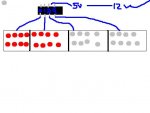'led_test.bas
'Generate pretty LED patterns.
'Author unknown, modified by CPS May '98.
'This is the test program downloaded to
'Revolution's Stamp Controller to test the
'pcb for correct operation before despatch.
'Load some pretty patterns into EEPROM memory.
#picaxe 18x '******
eeprom ($0,$0F,$F0,$3C, $C3,$18,$3C,$7E, $FF,$E7,$C3,$81)
eeprom ($0,$03,$06,$0C, $30,$60,$C0,$60, $30,$0C,$06,$03, 0)
'Define symbols
symbol i = b0
symbol j = b1
symbol k = b2
'Define time delays
symbol const1 = 50
symbol const2 = 150
'Main program
'The let dirs= line is only required with the Stamp
'For PICAXE systems comment out the line using a '
'let dirs = %11111111 'all pins output!
'change Loop to Looper **********
Looper: For i = 0 To 7 'bar climbing
pause const1
high i
Next i
For i = 0 To 7 'and disappearing...
pause const1
low i
Next i
Let j = 1 'single light moving up
For i = 0 To 7
Let pins = j
pause const1
Let j = j + j
Next i
Let j = 64 'and rolling back
GoSub roll_back
Let j = 3 'bar climbing up
For i = 0 To 6
Let pins = j
pause const1
j=j+j|1
Next i
j = 127 'and rolling back
GoSub roll_back
For i = 0 To 24 'some more effects
read i, j
Let pins = j
pause const2
Next i
goto looper 'loop forever!
'change Loop to Looper
'sub-procedures
roll_back:
For i = 0 To 6
Let pins = j
pause const1
j = j / 2
Next i
Return

